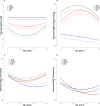IQ trajectories in autistic children through preadolescence
- PMID: 37397281
- PMCID: PMC10241474
- DOI: 10.1002/jcv2.12127
IQ trajectories in autistic children through preadolescence
Abstract
Background: We extended our study of trajectories of intellectual development of autistic individuals in early (mean age 3 years; T1), and middle childhood (mean age 5 years, 7 months; T2) into later middle childhood/preadolescence (mean age 11 years, 6 months; T3) in the longitudinal Autism Phenome Project cohort. Participants included 373 autistic children (115 females).
Methods: Multivariate latent class growth analysis was used to identify distinct IQ trajectory subgroups. Baseline and developmental course group differences and predictors of trajectory membership were assessed using linear mixed effects models with repeated measures with pairwise testing, multinomial logistic regression models, and sensitivity analyses.
Results: We isolated three IQ trajectories between T1 and T3 for autistic youth that were similar to those found in our prior work. These included a group with persistent intellectual disability (ID; 45%), a group with substantial increases in IQ (CHG; 39%), and a group with persistently average or above IQs (P-High; 16%). By T3, the groups did not differ in ADOS-2 calibrated severity scores (CSS), and there were no group differences between Vineland (VABS) communication scores in CHG and P-High. T1-T3 externalizing behaviors declined significantly for CHG, however, there were no significant T3 group differences between internalizing or externalizing symptoms. T1 correlates for CHG and P-High versus ID group membership included higher VABS communication and lower ADOS-2 CSS. A T1 to T2 increase in VABS communication scores and a decline in externalizing predicted CHG versus ID group membership at T3, while T1 to T2 improvement in VABS communication and reduction in ADOS-2 CSS predicted P-High versus ID group membership.
Conclusions: Autistic youth exhibit consistent IQ developmental trajectories from early childhood through preadolescence. Factors associated with trajectory group membership may provide clues about prognosis, and the need for treatments that improve adaptive communication and externalizing symptoms.
Keywords: IQ; adolescence; autism; early childhood; intellectual development; outcomes; trajectories.
Conflict of interest statement
Conflicts of Interest Drs. Solomon, Iosif, Nordahl, Cho, Heath, and Ferrer and Mr. Srivastav report no biomedical financial interests or potential conflicts of interest. Dr. Amaral is on the Scientific Advisory Board of Stemina Biomaker Discovery and Axial Biotherapeutics.
Figures


References
-
- Achenbach, T. M. , & Rescorla, L. (2001). ASEBA school‐age forms & profiles. In Aseba burlington.
-
- Achenbach, T. M. , & Rescorla, L. A. (2000). ASEBA preschool forms & profiles. University of Vermont, Research Center for Children, Youth and Families.
-
- Bandeen‐Roche, K. , Miglioretti, D. L. , Zeger, S. L. , & Rathouz, P. J. (1997). Latent variable regression for multiple discrete outcomes. Journal of the American Statistical Association, 92(440), 1375–1386. 10.2307/2965407 - DOI
-
- Bishop, S. L. , Guthrie, W. , Coffing, M. , & Lord, C. (2011). Convergent validity of the Mullen Scales of Early Learning and the differential ability scales in children with autism spectrum disorders. American Journal on Intellectual and Developmental Disabilities, 116(5), 331–343. 10.1352/1944-7558-116.5.331 - DOI - PMC - PubMed
